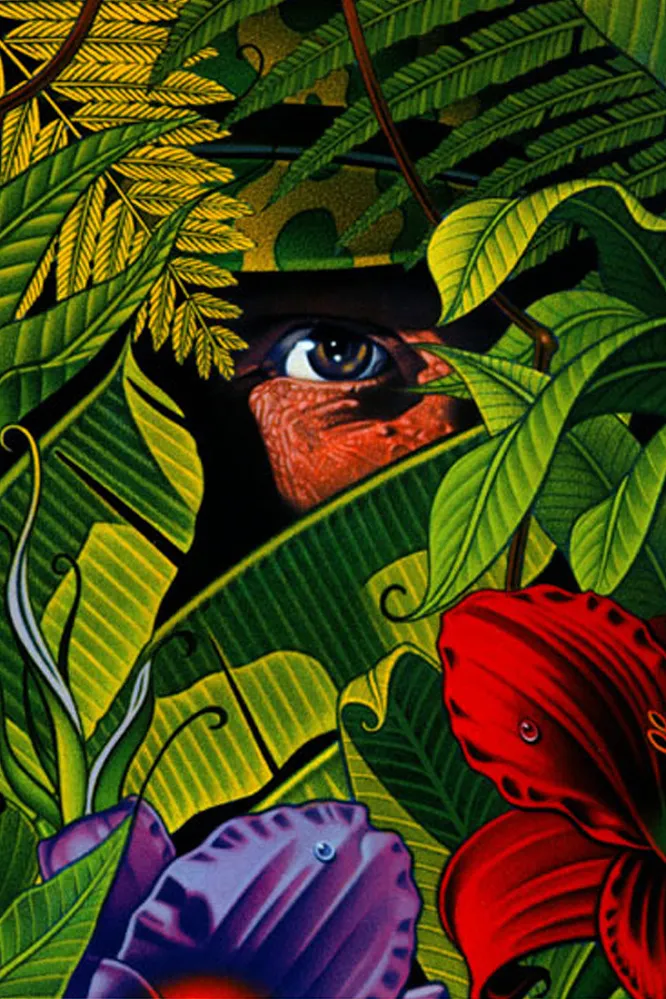Copyright Foreign Policy

In short stories like “R&R” and “Salvador,” Shepard, who died in 2014, depicts the United States launching a Central American conflict that has turned into a second Vietnam. It’s a sprawling, endless war where U.S. soldiers massacre villagers while high on government-provided amphetamines and psychedelics. (Many of the stories are collected in two volumes from Subterranean Press that had limited print runs but are readily available as an eBook.) Shepard came to fiction late, attending the Clarion Science Fiction and Writer’s Workshop, a crucible of great authors, in Michigan in 1980 when he was 37, after years of traveling. His early stories won instant acclaim from readers and writers, but he never had the breakthroughs that would come to contemporaries like George R.R. Martin. Even in his publishing heyday, Shepard noted that he “never achieved enough celebrity to make a ripple in a bird bath.” Partially that’s because he was always more comfortable with the short story and novella than longer fiction, although he published some of his Latin America war stories in 1987’s Life During Wartime as a “fix-up,” a publishing term mostly used for sci-fi when previously published short stories are turned into a novel. After the burst of brilliant Latin America and Vietnam stories of the 1980s he went relatively quiet for a few years, before returning in the 1990s with a new focus on North America. He moved on in part because the times had changed. His Latin American war stories were a vision of the future based on the reality of the day. In the early 1980s, the U.S. military and CIA were deeply entangled in Central America, supporting dictatorial regimes in the name of anti-communism and the war on drugs. The United States trained the murderous Salvadorean military and provided instruction manuals for torture at the “School of the Americas” in Panama. Special forces fought a secret, undeclared war on the ground. Central America wasn’t Shepard’s only influence: In passing, he also built into his future history a U.S. war in a post-Soviet Afghanistan. But despite the plausibility of the wars in his plots, Shepard was more of a magical realist than a hard science fiction author. His stories exist in a strange space between plausible technology and hallucination sorcery, the near-future of the 1980s mixed with the sense of otherworldly wonders and horrors. In the same conflict a character can be riding “the new Sikorsky gunships” or beside “three infantrymen who were still wearing their combat suits and helmets, holding double-barreled rifles that were connected by flexible tubing to backpack computers; through their smoked faceplates he could see green reflections from the readouts on their visor displays.” Or they can be in the jungle, led by the spirit of a massacred village, realizing, “It was no forest, but a building of solid gold worked to resemble a forest—the sort of conceit that might have been fabricated for the child of an emperor. Canopied by golden leaves, columned by slender golden trunks, carpeted by golden grasses. The water beads were diamonds.” The stories have a constant undercurrent of threat, his characters walking the edge between drug-fueled paranoia and legitimate fear. As in the books of one of his models, Philip K. Dick, the U.S. state is occult and classified, but also self-contradictory, confused, and self-destructive. In “R&R,” two helmeted U.S. pilots tell the grunts they’re transporting that they can’t lift their visors because their own military has experimented upon them. It’s never clear whether they’re bullshitting or not: “‘You don’t wanna see us, nohow,’ said the first pilot. ‘The beams fuck up our faces. We’re deformed-lookin’ mothers.’ “‘Course you might not notice the changes,” said the second pilot. ‘Lotsa people don’t. But if you did, it’d mess you up.’” His characters move through landscapes warped by war, both figuratively and literally. Sometimes it’s trade following the flag, like “San Francisco de Juticlan […] less a town than a symptom of war,” packed with brothels and drug dealers and other war profiteers. In the short story “The Arcevoalo,” the wars are five centuries past but have permanently warped the wildlife of Brazil, making “flying lizards that spit streams of venom; albino peacocks whose shrill cries could make a man bleed from the ears; the sortilene, a mysterious creature never glimpsed by human eyes, known only by the horrid malignancies that sprouted from the flesh of its victims; herds of peccaries, superficially unchanged but possessing vocal chords that could duplicate the cries of despairing women.” More than anything else, his works are about the uncanniness of war, about a world so distorted and inexplicable that mundane reality has broken down. As the great U.S. critic Lee Sandlin wrote of World War II, “The truth was, the only language that seemed to register the appalling strangeness of the war was supernatural … Even the most routine event of the war, the firing of an artillery shell, seemed somehow uncanny. The launch of a shell and its explosive arrival were so far apart in space and time you could hardly believe they were part of the same event, and for those in the middle there was only the creepy whisper of its passage, from nowhere to nowhere, like a rip in the fabric of causality.” The war that haunts Shepard is, unsurprisingly for his generation, Vietnam. His drug-soaked G.I.s, haunted jungles, and purposeless conflicts are sometimes just visions of that conflict transferred to the Americas. Two of his best stories are set in Vietnam itself. In “Delta Sly Honey,” military radio starts to carry the threats and promises of dead soldiers. His 1987 story “Shades” anticipates Heonik Kwon’s study “Ghosts of War in Vietnam”: A communist scientist has invented a machine to communicate with the specters haunting former battlefields and needs a U.S. soldier-turned-journalist to talk to a fallen comrade. Yet Shepard also knows these are real places with their own people and histories, not just backdrops for U.S. angst. Many of his protagonists are local, especially Indigenous people, and his love of the countries he had spent years in palpable: “The crowds that moved along the road were composed mostly of Indians: young couples too shy to hold hands; old men who looked lost and poked litter with their canes; dumpy matrons who made outraged faces at the high prices; shoeless farmers who kept their backs ramrod-straight and wore grave expressions and carried their money knotted in handkerchiefs.” The details of Shepard’s life are scanty and unclear, in part because he liked them that way. His self-written biography claimed he was born in 1947, but he was actually born in 1943. The Science Fiction and Fantasy Writers of America states in his obituary that he was a Vietnam veteran, but seems to have confused his life with his fiction; Shepard described his work as having “received generally [favorable] reaction from vets,” a group in which he didn’t include himself. He disclaimed his first publications as a child, claiming they had been written by a family member in his name without his knowledge. But one thing about his life that’s clear is travel. From early adulthood onward—perhaps as young as 15, although his own telling is unreliable—he wandered the world, especially Southeast Asia, North Africa, and Latin America, working odd jobs that varied from bouncer to janitor to drug dealer to musician. In between, he briefly attended the University of North Carolina. Much of this was spent demonstrating his “legendary” capability for drugs and alcohol, as well as struggling with intermittent bouts of severe depression. A strange and brilliant man produced some of the best short science-fiction of his day. If the United States embarks on a fresh military adventure, the result is likely to be even more horrific and strange than anything Shepard could conjure up—and the ghosts left behind will linger for generations.



